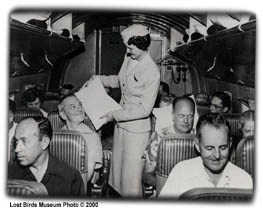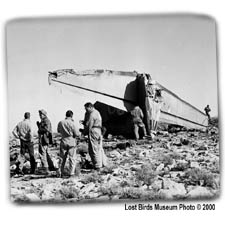|
 Story by Doug
Scroggins (c)
2000 - 2013
Story by Doug
Scroggins (c)
2000 - 2013
Bonanza Air
Services (BAS) was formed in early in 1945 by Edmund
Converse, a former lieutenant commander in the U.S. Navy;
Charlie Keene, once an operator of a small charter
operation in Santa Paula, California; and June Simon,
daughter of "Pop" Simon the former
secretary-director of the Las Vegas Chamber of Commerce.
BAS located its home base at the Sky Haven Airfield, now
known as the North Las Vegas Air Terminal, and began
operating with just one single-engine, four-seat Cessna.
The company offered charter flights to several small
Nevada towns but needed a place to promote its product.
The trio struck a deal with the El Rancho Vegas
Hotel and Casino to set up a ticket counter in the lobby.
Late in 1945
the trio set in motion a plan to expand the business,
changing its name from Bonanza Air Services to Bonanza Air
Lines (BAL) and incorporating the company. The home base
was moved to Alamo Field, now known as McCarran
International Airport, in early 1946. As the operation
grew, additional aircraft were acquired including two
single-engine Piper Cubs and three military surplus
twin-engine Cessna T-50 Bobcats for the charter services.
In addition, a Stearman biplane was acquired for the new
flight school division.
 |
Bonanza
Air Services
first passenger
fleet of Cessna T-50s.
Scroggins
Aviation photo
|
The operation grew quickly in
1946 when BAL secured a contract to ferry merchant marines
from California to New Jersey. In order to fulfill the
contract, BAL leased it's first Douglas C-47 from the War
Assets Administration in March of 1946.
Bonanza's
Douglas Co.
C-47 (DC-3)
Lost
Birds / Scroggins Aviation photo
|

|
On December 19, 1949,
Bonanza inaugurated a newly awarded route between Reno and
Phoenix with stops in Carson City, Hawthorne, Tonopah, Las
Vegas, Boulder City, Kingman and Prescott. Shortly
thereafter, the Civil Aeronautics Board (CAB) approved
BAL's request to provide mail service on the route with
U.S. Mail Permit No. 105. Also granted was a federal
certificate to engage in interstate commerce and the
exchange passengers, air express and air freight with
other federally certificated airlines.
BAL's new routes and
services required the addition of still more aircraft and
personnel. McCarran Field, formerly Alamo Field, did not
have enough hanger space to accommodate the newly acquired
fleet, so Bonanza purchased a surplus military hanger at
Reno, then dismantled and transported it to McCarran
Field. The entire operation, completed in less than a
month, allowed use of the hanger by June 1950.
 |
Passenger
cabin of a
Bonanza Air
Lines
DC-3
Lost
Birds / Scroggins Aviation photo
|
With the additional space
it was again time to look at expansion, this time to
California. The first route was awarded in July 1952, from
Phoenix to Los Angeles, via Ajo, Yuma, Blythe, El Centro,
San Diego, Oceanside and Santa Ana-Laguna Beach. This was
the first of many new segments awarded in the years that
followed.
BAL was flying 10 DC-3s by
1957. AS the route map grew, it became even more evident
that this fleet was outdated. Eight of the company's top
executives, including Edmond Converse, flew to Europe and
meet with the Fokker aircraft in Holland, inspecting the
manufacturer's new F.27 turboprop airliner. This aircraft
featured speeds well in excess of the DC-3, and seated 40
passengers in pressurized comfort. BAL placed the order in
May1956 for three Fairchild F-27As with an option to
purchase three additional aircraft, all could be delivered
in 1959. Fairchild built the Fokker variant on license in
the United States (Friendship With a Difference, November/December
1997).
| Bonanza's
Fairchild
F-27A "Silver Dart" seen here at the Los
Angeles airport.
Lost
Birds /AMA Photo.
|

|
With the airline's rapid
growth, additional F-27As were purchased and quickly put
into service; a total of 11 would eventually be acquired.
Meanwhile, the last DC-3 was phased out in November 1960,
causing a huge media promotion. A logo proclaiming Bonanza
as the "First all jet-powered airline in
America!" was applied to everything from the Silver
Darts to flight schedules and bumper stickers. The
complete transition from DC-3 to F-27A had taken only 20
months. With it came some fairly lengthy nonstop flights,
such as Las VegasReno, 344-mile segment flown in two
hours and 15 minutes.
 |
Wreckage
of one of Bonanza's
"Sliver Darts"
Lost
Birds / Scroggins Aviation Photo.
35th
Anniversary of Flight 114.
Local
newspaper features story of crash.
CLICK
HERE: BAL
#114 to view story
|
1964 was the most
profitable year in the companies history, however the year
took a terrible turn with the loss of the first plane.
November 15, 1964, flight 114 (N745L) crashed 10 miles
north of Las Vegas killing all 29 persons aboard. Inbound
from Phoenix, Arizona during a snow storm the plane struck
a mountain top less than 5 minutes from the airport. After
years of legal battles, U.S. District Court Judge Pierson
Hall concluded that the landing charts provided by
Jeppeson were the "main proximate cause" of the
crash. However,
the lower court finding was appealed. It was
“reversed and remanded.” 642 F.2d 339 (9th
Cir. 1981)
| Tail
section of the Silver Dart lies on a mountain top
south of Las Vegas.
Lost
Birds / Scroggins Aviation Photo.
|

|
BAL ordered three DC-9's
with an option to purchase three more. Once again BAL
chose a distinctive name for the new additions to the
fleet, the DC-9's would be known as the "FanJet".
On December 21, 1965 the first DC-9 (N945L) was delivered
and made it's inaugural flight on March 1, 1966. With the
addition of the DC-9's BAL would need a larger facility
that would accommodate the height of the vertical fin. BAL
submitted a plan to Clark County for a new facility but
was turned down.
 |
Bonanza's
first Douglas Co. DC-9 "Funjet" (N945L)
BAL
Photo |
The City of Phoenix made
BAL an attractive offer to build a new headquarters and
maintenance hanger at the Sky Harbor Airport. They would
design the buildings around the new DC-9's specifications
and BAL accepted the offer. On June 25, 1966 Charles
Murphy, Chairman of the CAB, officiated at the opening
ceremony for the new facility.
Mexico was the next and
would be the last route BAL would be awarded prior to a
planned merger. On April 28, 1968 the inaugural flight was
made from Phoenix, Arizona to Puerto Vallarta, Mexico with
stops in Tucson, Arizona and La Paz and Mazatlan, Mexico.
In mid 1967 discussions
were underway for a merger with West Coast and Pacific
Airlines which would create Air West, Inc. In August of
that year BAL announced it had reached an agreement with
the two carriers, and on April 17, the merger was granted
by the CAB and President of the United States, Lyndon B.
Johnson. The merger would place the new corporate
headquarters of Air West in the Pacific Airlines office in
San Francisco, California, and the BAL headquarters in
Phoenix was turned into the maintenance facility for the
fleet.
Bonanza Air Lines was the
aviation pioneer in the western United States and proved
to be a vital link in the air transportation industry. In
it's 23 years of operation BAL growth continued up until
the time of the merger. Bonanza will be remembered as a
successful airline.
Please send your inquiries to: museum@BonanzaAirlines.com or
write to the address below.
|
|
